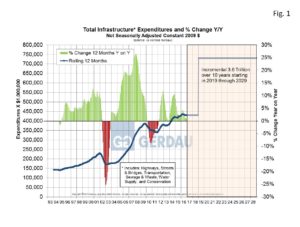U.S. Infrastructure
The American Society of Civil Engineers (ASCE) issues a report card on the health of infrastructure in America on a four year cycle. The 2017 report was just released and the overall score was “D+” on an A to F scale, the same score as the previous report.
There are 16 categories that the ASCE considers that make-up the nation’s infrastructure. The categories include: Aviation, Bridges, Dams, Drinking water, Energy, Hazardous waste, Inland waterways, Levees, Ports, Public parks, Rail, Roads, Schools, Solid waste, Transit and Waste water. The grades have been near failing since 1998, averaging only Ds, due to delayed maintenance and underinvestment across most categories. The ASCE estimates that an investment of $3.6 Trillion (T), is required to bring our infrastructure to standard. According to ASCE, not having a competitive infrastructure costs the economy $3.9 T annually to our GDP. Therefore the return on investment is very good.
The best score in the 2017 report card was a “B” for rail systems, the vast majority of which is privately held. The private sector has done a good job investing in rail infrastructure that carries approximately 1/3 of US exports and delivers 5 million tons of freight and 85,000 passengers each day. The lowest score was “D-“ for transit, yet despite increasing demand, the nation’s transit systems are chronically underfunded. This aging infrastructure is estimated to require $90B in rehabilitation to bring it back to standard.
In this report, we will review the some of the categories that consume large tonnage of long product steel.
Aviation: Score “D”. Air traffic control systems are simply not keeping up with today’s sophisticated aircraft. Last year 24 of 30 of the nation’s largest and busiest airports reported at least one day per week of “Thanksgiving volume”. ASCE estimates a $42B funding gap to bring the systems into compliance. Last week the Trump administration raised the idea of privatizing air traffic control. Privatization of infrastructure needs would likely accelerate investment.
Bridges: Score “C+”. According to ASCE, there are 0ver 614,000 bridges in the US. Four out of 10 are greater than 50 years old and 9.1% are considered structurally deficient. ASCE estimates that 188M trips per day are made on these structurally deficient bridges. The estimate to bring the nation’s bridges up to standard is $123B.
Energy: Score “D+”. Much of the nation’s power transmission was constructed in the 1950 and sixties with a 50 year life expectancy. The nation’s power grid is at full capacity leaving little room for incremental demand. Without greater attention, bottlenecks and power outages will become more commonplace.
Dams: Score “D”. The average age of the over 90,000 dams in the US is 56 years. The number of critical high hazard potential dams increases each year to a lack of investment in maintenance and repair. That number is now estimated to be 2,170. ASCE estimates that $45B is required to bring theses dams to standard.
Schools: Score “D+”. An estimated gap of $38B per year would be required to bring the nation’s schools to standard. Currently 24% of the nation’s public schools are rated as either fair or poor.
Levees” Score “D”. An estimated $80B over the next 10 years is required to maintain and improve the US Army Corp. system of levees. These levees protect an estimated $1.3T worth of property. In 2014, Congress passed the Water Resources Reform Act which was to expand the levees safety program nationwide. To date there has been zero funding.
Figure 1  illustrates what it would look like to make the ASCEs recommended $3.6T investment in infrastructure over a ten year period relative to history going back to 1993. The area under the curve appears to be greater than the entire timeframe from 1993 to 2016. Spending on infrastructure is necessary to remind competitive in an increasingly global marketplace. There is some initial talk of creating a $1T infrastructure bill in Washington. We desperately need to improve our crumbling infrastructure. Hopefully this money will be appropriated before there is another bridge collapse our levee failure.
illustrates what it would look like to make the ASCEs recommended $3.6T investment in infrastructure over a ten year period relative to history going back to 1993. The area under the curve appears to be greater than the entire timeframe from 1993 to 2016. Spending on infrastructure is necessary to remind competitive in an increasingly global marketplace. There is some initial talk of creating a $1T infrastructure bill in Washington. We desperately need to improve our crumbling infrastructure. Hopefully this money will be appropriated before there is another bridge collapse our levee failure.
At Gerdau, we regularly monitor spending on infrastructure since it has a huge impact on steel sales, particularly long products, which we produce and market to you our valued customers.

